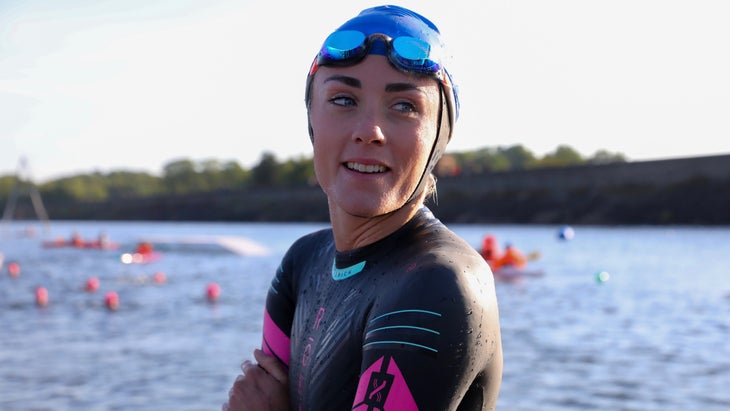New perk! Get after it with local recommendations just for you. Discover nearby events, routes out your door, and hidden gems when you sign up for the Local Running Drop.
Twelve days before WTCS Leeds—one of the biggest remaining pre-Olympic draft-legal events in the world—Lucy Charles-Barclay was training just like any long-course triathlete. She was in Lanzarote, Spain, for a big block with her eyes set on Kona in October. But the next day, everything would change.
“I got a WhatsApp message this morning saying, ‘you’re on the start line for Leeds,’” she told viewers on YouTube. “I’ve got a week-and-a-half, 11 days, until the race, and I’m waiting to see a bit of an updated training plan to work on some things, because I want to do the race, but also don’t want to look like an idiot. So yeah, I need to change my plan.”
At the end of 2020/early 2021, the British triathlon federation had reached out to Charles-Barclay, telling her she might be a good fit for the draft-legal program. With that in mind, Charles-Barclay participated in the ZPro Series and the Super League Arena Games in London in March. But after arriving in Lanzarote five weeks prior, she was told by the British tri federation that a start at Leeds would be very unlikely given the interest by other racers—also given the tightened schedule and Olympic year.
As such, she had pivoted back to long-course training and shelved her short-course aspirations. When they finally gave her that unexpected green light with 11 days to go, she had done no crucial short-course transition training or draft-legal specific bike handling work. The good news is her swim is on point, so she’ll be able to make the front pack or a breakaway, no problem—as seen with her performance at the British Olympic swimming trials back in April.
RELATED: Lucy Charles-Barclay Takes Second at the British Olympic Swimming Trials
In the days since learning about her start at Leeds, she’s spent time in Lanzarote working on cornering and turnarounds (both of which are huge in ITU racing), but notably absent from that practice was any practice on wet pavement—something she’ll very likely encounter. She also spent the week working on transitions—mounts, dismounts, quick through T1, etc.—all super important because if she doesn’t make the first break (or she gets caught by the main pack), she’ll be in serious trouble with all of those fleet-footed short-course runners.
After Leeds, she says she’ll refocus on middle-distance racing with her eyes still set on Kona, unless anything drastic changes (again).

U.S. Olympic Team Slots On The Line In Leeds
For those who have had more than 11 days preparation, there’s plenty else on the line this weekend in Leeds too. As of this writing, the U.S. men and women each have three allocated spots for Tokyo—which could easily change in the next two weeks. After an inspiring win by Jonathan Brownlee in Arzachena, the British men are looking to make a case for their third spot at Tokyo (they currently only have two).
In the Race Inside The Race, keep your eyes peeled for performances from male “on-the-bubble athletes” like Tom Bishop from the U.K. A killer performance from him (or a bad performance from him) could hold huge implications for his entire country’s Olympic spot allocation. Between Leeds and the Huatulco World Cup in Mexico on June 13 (where other U.S. “bubble boys” like Eli Hemming and Kevin McDowell will race), it’ll come down to the wire for the allocations deadline on June 14, and no country wants the tough decision of only sending two male athletes to the Games.
RELATED: Who Will Get Three Men’s Olympic Spots: The U.S. or Britain?
Speaking of tough decisions, the U.S. Olympic selection committee will be glued to the Leeds race feed to help tease out the rightful Olympians from their current group of high-level women (more on this here).
After an admittedly disappointing race in Yokohama, Katie Zaferes went back to Girona, Spain, to join her squad in final preparations for Leeds. The 2016 Olympian and former world champion struggled and finished 22nd place at Yokohama, while Taylor Knibb stole the show—winning the race and pocketing the second and final automatic U.S. Olympic slot. Only slightly further back, Taylor Spivey finished in fourth, just out of reach of the final non-discretionary spot on the team.
With all of the non-discretionary slots for the U.S. Olympic team taken, we’ll see a lot of painstaking analysis by the selection committee members, and Leeds will clearly play a big part. The committee is composed of USAT high performance general manager John Farra, independent representative Shane Domer (from U.S. speedskating), USAT Level III coach Kathleen Johnston, and 2012/2016 Olympian Sarah True.

Not only will the group be taking into account the results at Leeds—particularly for the women—but they’ll also look at previous performances from as far back as March 2019. This is important to note because despite Zaferes’ recent fumbles (crashing at the Tokyo test event in 2019 and her recent result in Yokohama that came on the heels of the recent passing of her father), she is still in the hunt. That said, barring any miracles, there’s a good chance that the choice will be between Spivey (who most recently took fourth in Yokohama and fourth at Hamburg WTC last year—both ahead of the 2016 Olympian/world champion) and Zaferes.
RELATED: Sleepless Nights at USAT
One final note from the oddsmakers: Zaferes has placed third and second in Leeds before (in 2018 and 2019, respectively), while Spivey was seventh and fourth in the same years. With a different course—and the fact that it’s been 24 long months since—those data points might be moot, but it’s still something to consider.
The World Triathlon Series Championships race in Leeds, England will take place on Sunday afternoon local time. Stay tuned for how to watch later this week.
